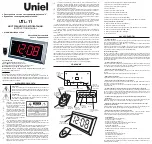
3
English
Radio Controlled Alarm Clock
Art.no 36-5333 Model E0062-DCF
Please read the entire instruction manual before using the product and save it
for future reference. We reserve the right for any errors in text or images and any
necessary changes made to technical data. If you have any questions regarding
technical problems please contact our Customer Services.
Things to consider:
•
Other wireless equipment using the same frequency can reduce the transmission range.
•
The range of all wireless equipment depends on the type of obstacles located
between the transmitter and the receiver (e.g. a concrete wall will interfere with
the signal more than a plasterboard wall).
If you experience problems, try the following:
•
Turn off any other existing wireless equipment to check if this is the cause of
the problem.
•
Move any other existing wireless equipment. Shorten the distance between
the transmitting and receiving devices and reduce the number of obstacles
(walls, furniture, etc) between them.
What is a radio controlled clock?
A radio controlled clock is extremely accurate. The time is controlled by the atomic
clock in Braunschweig, Germany (accuracy ±1 second per 1 million years). The clock
contains a radio receiver that decodes the time signal sent from the atomic clock (long
wave 77.5 kHz) and adjusts the time of your clock accordingly. The clock also has
an precisely calibrated quartz clock movement with a frequency of 32 kHz that keeps
it running.
The transmitter in Germany has an official range of 2,000 km. This means that the UK
and Ireland should be well within range.
Safety
•
The alarm clock must only be repaired by qualified service technicians.
•
The alarm clock is intended for indoor use only.
•
Do not place the alarm clock where there is a risk of it falling into water or other liquid.
•
Do not place the alarm clock in damp or dusty environments or where there are
strong vibrations.
•
Do not expose the alarm clock to extremely high or low temperatures. Do not
expose the alarm clock to direct sunlight.
•
Never try to open, change or modify the alarm clock in any way.
•
Always remove the batteries if the alarm clock and the outdoor sensor are not to
be used for a long time.
Summary of Contents for EN0062-DCF
Page 2: ...2 ...




































